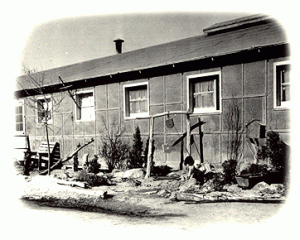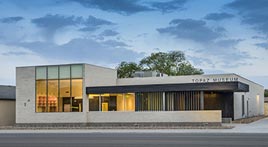FACTS ABOUT THE TOPAZ CAMP

- Opened on September 11, 1942
- Closed on October 31, 1945
- The original name, Central Utah Relocation Center, was changed to Abraham Relocation Center, and then to Topaz because the original name was too long to fit on postal forms, and the nearby town of Abraham already had a post office. The name Topaz came from a nearby mountain. The camp was never named after Delta.
- Location: 10000 to 11000 West on 4500 North, 16 miles northwest of Delta, Utah, which is 130 miles southwest of Salt Lake City
- Climate: Arid desert temperatures range from over 100 degrees in the summer to below zero in the winter.
- Cost to build: $3,929,000
- Incarcerees: 11,212 were processed into the camp. Peak population was between 8100 and 8300. Most of the people came from the San Francisco Bay area.
- Size: 19,800 acres (31 square miles), including farmland
- Living area: 640 acres (one square mile) surrounded by four-foot-high barbed wire fence and guard towers every half mile on three sides. Of the 42 blocks, 36 were used for housing.
- Blocks held about 250 incarcerees and were comprised of 12 barracks, a mess hall, latrine and laundry, and recreation hall. Each recreation hall was used by the entire community and functioned as co-op stores, churches, art school, libraries, pre-schools, and other uses.
- Living spaces: Each 20’ x 120’ barrack was divided into six rooms of three different sizes: 20’ x 16’, 20’ x 20’, and 20’ x 24’. Families were assigned rooms depending on the number of people in the family. If the family was larger than six people, they had multiple rooms. The barracks had no running water, a single light, and were heated by a coal stove.
- Assembly center: Prior to being taken to Topaz, people were detained in the Tanforan and Santa Anita Racetracks in California. Many incarcerees were forced to live in horse stalls while waiting for Topaz to be completed.
- Once at Topaz, incarcerees were hired to work at the camp. Pay ranged from $14 a month for secretaries and janitors to $19 per month for professionals, including medical doctors.
- People could leave Topaz and go farther east away from the West Coast, if they had a job or were admitted to a school. They could not return to California until January 1945.
- After the War Relocation Authority (WRA) required all people 17 or older to answer loyalty questions, men were drafted and volunteered for military service from Topaz.
- The soldiers were part of the 442nd RCT and the Military Intelligence Service, while many of their families were still interned.
- If people answered “No” to two questions on the loyalty questionnaire, they were sent to the segregated camp, Tule Lake, and threatened with deportation to Japan.

Photo: Brian Buroker
Help Support Our Museum
FACTS ABOUT THE TOPAZ CAMP

- Opened on September 11, 1942
- Closed on October 31, 1945
- The original name, Central Utah Relocation Center, was changed to Abraham Relocation Center, and then to Topaz because the original name was too long to fit on postal forms, and the nearby town of Abraham already had a post office. The name Topaz came from a nearby mountain. The camp was never named after Delta.
- Location: 10000 to 11000 West on 4500 North, 16 miles northwest of Delta, Utah, which is 130 miles southwest of Salt Lake City
- Climate: Arid desert temperatures range from over 100 degrees in the summer to below zero in the winter.
- Cost to build: $3,929,000
- Incarcerees: 11,212 were processed into the camp. Peak population was between 8100 and 8300. Most of the people came from the San Francisco Bay area.
- Size: 19,800 acres (31 square miles), including farmland
- Living area: 640 acres (one square mile) surrounded by four-foot-high barbed wire fence and guard towers every half mile on three sides. Of the 42 blocks, 36 were used for housing.
- Blocks held about 250 incarcerees and were comprised of 12 barracks, a mess hall, latrine and laundry, and recreation hall. Each recreation hall was used by the entire community and functioned as co-op stores, churches, art school, libraries, pre-schools, and other uses.
- Living spaces: Each 20’ x 120’ barrack was divided into six rooms of three different sizes: 20’ x 16’, 20’ x 20’, and 20’ x 24’. Families were assigned rooms depending on the number of people in the family. If the family was larger than six people, they had multiple rooms. The barracks had no running water, a single light, and were heated by a coal stove.
- Assembly center: Prior to being taken to Topaz, people were detained in the Tanforan and Santa Anita Racetracks in California. Many incarcerees were forced to live in horse stalls while waiting for Topaz to be completed.
- Once at Topaz, incarcerees were hired to work at the camp. Pay ranged from $14 a month for secretaries and janitors to $19 per month for professionals, including medical doctors.
- People could leave Topaz and go farther east away from the West Coast, if they had a job or were admitted to a school. They could not return to California until January 1945.
- After the War Relocation Authority (WRA) required all people 17 or older to answer loyalty questions, men were drafted and volunteered for military service from Topaz.
- The soldiers were part of the 442nd RCT and the Military Intelligence Service, while many of their families were still interned.
- If people answered “No” to two questions on the loyalty questionnaire, they were sent to the segregated camp, Tule Lake, and threatened with deportation to Japan.

Photo: Brian Buroker